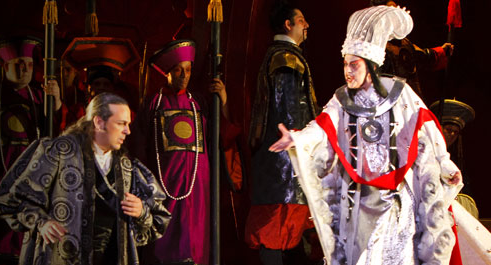Seattle Opera’s Turandot runs from August 4 to 18 at McCaw Hall.
In Puccini’s opera Turandot, based first on a play by Carlo Gozzi, with its roots in a much older Persian tale, you have one of the most popular operas of all time, about a formidable Chinese princess who tests her suitors, with the failures (and everyone fails) executed. While opera’s vocal meritocracy has long depended upon colorblind casting for many roles, it’s also true that most Turandots have not been Chinese, or Asian. (Seattle Opera’s sopranos, Lori Phillips and Marcy Stonikas, are from Rhode Island and Illinois, respectively.)
But audiences have generally agreed, except in particular cases, that skin color, along with size and age in opera, is “more of a guideline”–what matters is how well the performer sings and acts the role. Unless the character is supposed to be a specific hue, the colors of the voice matter more, in theory.
So imagine the perplexity of Moisés Kaufman and Spring Awakening‘s creative duo, Duncan Sheik and Steven Sater, when their new musical The Nightingale managed to ire the Asian acting community. A retelling of Hans Christian Andersen’s fable, about the Chinese emperor enthralled by first a real nightingale and then a mechanical version, The Nightingale, as workshopped at La Jolla Playhouse, featured a multiracial cast that was notably short on Asian actors, let alone specifically Chinese talent.
At a talkback (scheduled to address the blowback), Kaufman emphasized that this was, after all, a fable, set in a “mythic China”–a defense that did not seem to persuade an audience literate in cultural appropriation. After all, it would seem to advance the case for a strangely selective blindness if you include Chinese scenery and miss the people who should be in it, even if they are portrayed by an actually multiracial cast (as opposed to mainly Caucasian actors and a lonely hyphen-American).
That said, Andersen’s fable can be read many ways (including, reductively, as an allegory of his love for Jenny Lind), but is not usually hailed a pathbreaking work of cultural anthropology. Steven Sater told James Hebert that “we had a workshop that was fully Asian, and it’s not appropriate to the piece (we’ve written). It’s not about Asia.” It’s then that Sater brings up the term “chinoiserie.”
You could translate “chinoiserie” as “Chinese…ish,” if you want. It’s a cultural form of infatuation with the transfer student–in retrospect it may come to seem childish and superficial. But initially, there’s a flush of novelty, a flash of curiosity, and a fleshing out of another inner life through trial and error, mostly error. (In a similar way, knock-offs of products are usually not very good, most fail, and a few develop into something so good they rival the original–witness Japan’s whisky.)
Opera records many of these cross-cultural erotic attractions, sometimes intra-European, sometimes extra-, and the lesson is usually binary: Either the attractive foreigner is in basic ways just like us (Romance!), or in equally fundamental ways, not (Tragedy!). It’s not just about drama in scenic pagodas. Here’s conductor Asher Fisch on the ways Puccini worked the pentatonic and hijaz modes into Turandot‘s score, while reserving heart-pounding harmonies for the big emotions. (For Puccini, down deep everyone was an Italian opera fan, and history does seem to support his thesis.)
While they look to have so much in common, the hurdle that The Nightingale seems to face that Turandot doesn’t is that the The Nightingale was born today, while Turandot was born yesterday. Turandot is inextricably part of culture, an object with history; outside of your personal immersion (or not) in its story, it’s much like a grandparent’s faded photograph of that long-ago heartbreaker.
Its failings (three spring to mind, Ping, Pang, and Pong, which have to be carefully contextualized as commedia rather than casually racist) are those of another generation. It’s not so authentic in its depiction of China as in its failure to do so (authenticity is the more prized the more we struggle to identify ourselves–as cultures homogenize, cultural authenticity becomes a fetish, where liberals stash their conservatism). It is successful because “ice princess” turns out to be an archetype: Either you have tried to win someone’s heart, or you have been caught between your own head and heart’s contradictory urgings. (The true ice princess is not unfeeling, but feeling and frozen.)
Today, in La Jolla, you can’t simply wave a wand and call your China “mythic”–not because anyone in China knows or cares, necessarily, but because there are so many Americans of Chinese descent who bristle at it, and are willing to remind you that they’re in the audience.
Frankly, this is why mythic is adjective best applied by succeeding generations. Art is born in the here and now, out of material and immaterial phenomena, and it is in conversations like this that you get to see why it matters that people make art, rather than simply ingest the classics. Art may be a list of the problems of our time, but at least they are our problems.
